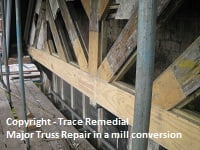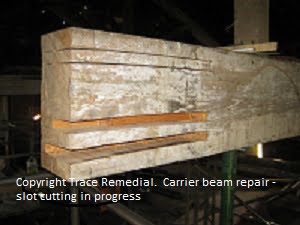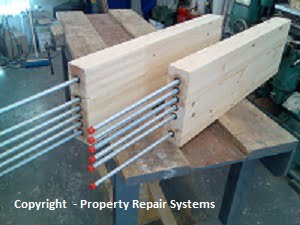Saving Wood in Buildings
David Moore, Property Repair Systems
Why treatment and repair using PCA member companies is the most sustainable approach
Around the UK, over the last 20 years, a small group of specialist Members of the Property Care Association (PCA) has pioneered the economic repair of large structural timbers. Why then do many building contractors largely prefer to rip out an entire original timber and replace it with steel and why are Structural Engineers still calculating all these repairs in steel?
Our new world economic conditions require:
- Renewable Materials – sustainable forestry
- Whole Life Cycle Costing – the real cost of scrapping sound timber, it’s disposal and the real cost of that new steel
- Minimal Opening Up – leave ceilings, roofs and decorations in place
Despite this, joists, carrier beams, purlins, bressumers, rafters and posts are all being scrapped as you read this article, for no good reason, yet routine repair using timber to timber resin/bar connection is well established, tried and tested. These techniques are known commercially as the ‘Timber-Resin Splice’ (TRS). The Timber Research and Development Association, TRADA, has also been deeply involved with resin repairs for many years and this work has culminated in a European-wide standard for timber-resin engineering, EUROCODE 5.

The Patented Timber-Resin Splice ‘repair kits’ have been in production for over 16 years, and there are over 10,000 successful installations on file. Each ‘kit’ incorporates the new timber unit, in matching timber, the resins for installation and the option of special Boron-based preservatives to treat the ‘parent’ beam. The main objectives of the ‘kit’ approach are;
- Existing structures can be preserved to prevent further decay
- Maintenance can incorporate the same techniques to extend life
- TRS Repairs minimise cutting back to the damaged zone only
This comprehensive approach needs to be adopted to minimise the loss of historical materials and structures – there is no longer any excuse for opening up and cutting back beyond the immediate zone of decay even in the worst cases of Dry rot.
The range of chemicals and new techniques not only prevent new outbreaks of fungal and insect attack, but also eradicate existing ones, even Dry rot deep inside large section structural timbers.

Epoxy resin repairs have been around a long time – certainly for over 25 years, but have always suffered through a combination of high material cost, and the high labour costs of constructing very strong, leak-proof shutters. In the Timber-Resin Splice(TRS) timber replaces timber, using only a small amount of resin to transfer the loads through the shear connector rods – what better way to reduce cost and increase practicality?
The buildings repaired using these new techniques range from cottages to castles and includes some famous sites – for example the castle next door to the filming location of the Laird of Glenbogle, Cluny Castle. But just as important to the owners, numerous ceilings have remained intact in very ordinary, domestic properties, saving disruption, dust and cost.
TRS technology, backed by sound, Structural Engineer calculated strength, enables us to repair in-situ timbers at the end bearing, mid span and in partial section providing the following major benefits;
- minimal use of expensive resin
- minimum damage to ‘parent’ timbers
- ‘heritage’ versions of attachment methods, for lowest disturbance
- ease of re-attachment of abutting structures (e.g. joists, struts etc.)
- no shuttering to build or remove, much lower labour costs
- cosmetic appearance – can be made in matching timbers, including hardwoods
- manufacturer Guaranteed for the life of the ‘parent’ timber
The original ‘solid’ resin repairs remain as an option – there are situations where they are still preferred (e.g. replacing the foot on a ground contact post or plate), but in the vast majority of situations the TRS Methods, (of which there are seven), can reduce material costs by up to 70% and labour costs by up to 80%!
These methods are designed to suit all the different access situations in which timbers can be reached to repair them – from above, from the sides and from below, with the addition of a special version of Type C (from above) for saving ceilings. This uses a 45 degree face angle and is particularly useful where the beam or joist has to be cut off very close to the wall face, quite usual where Wet rot has only affected the bearing itself.

So, the need exists and the Preservation Industry has pushed forward with these exciting techniques. Many of the best Remedial Contractors are offering to repair, rather than scrap timbers in buildings, offering true sustainability.
David Moore, Partner
Property Repair Systems
2013